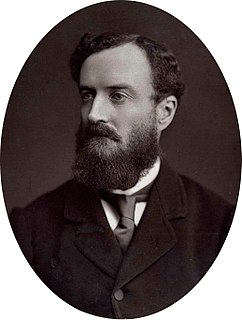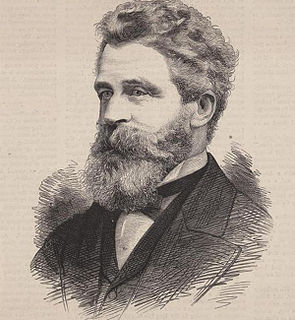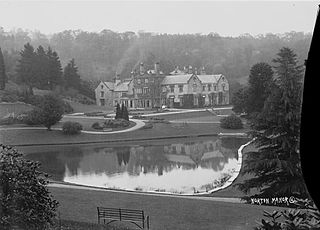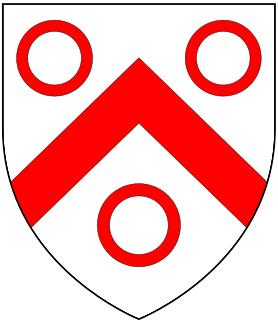
Earl Waldegrave is a title in the Peerage of Great Britain. It was created in 1729 for James Waldegrave, 2nd Baron Waldegrave.

Earl St Aldwyn, of Coln St Aldwyn in the County of Gloucester, is a title in the Peerage of the United Kingdom. It was created in 1915 for the prominent Conservative politician Michael Hicks Beach, 1st Viscount St Aldwyn, known from 1854 to 1907 as Sir Michael Hicks Beach, 9th Baronet, of Beverston. He was Chancellor of the Exchequer from 1885 to 1886 and again from 1895 to 1902. Hicks Beach had already been created Viscount St Aldwyn, of Coln St Aldwyn in the County of Gloucester, in 1906, and was made Viscount Quenington, of Quenington in the County of Gloucester, at the same time he was given the earldom. Both titles are in the Peerage of the United Kingdom. He was succeeded by his grandson, the second Earl, the son of Michael Hicks Beach, Viscount Quenington, Member of Parliament for Tewkesbury, who was killed in action in 1916. Lord St Aldwyn was also a Conservative politician and was Captain of the Honourable Corps of Gentlemen-at-Arms between 1958 and 1964 and 1970 and 1974. As of 2018 the titles are held by his eldest son, the third Earl, who succeeded in 1992.

Baron Bagot, of Bagot's Bromley in the County of Stafford, is a title in the Peerage of Great Britain. It was created on 12 October 1780 for Sir William Bagot, 6th Baronet.

There have been three baronetcies created for persons with the surname Croft, one in the Baronetage of England and two in the Baronetage of the United Kingdom. All three creations are extant as of 2008.

There have been five baronetcies created for people with the surname Pollock, one in the Baronetage of Nova Scotia and four in the Baronetage of the United Kingdom. As of 2017 three of the creations are extant. These three creations derive from the same family to which the 1703 baronetcy was granted; the Pollock ancestor of Sir Frederick Pollock, 1st Baronet and Sir George Pollock, 1st Baronet married his cousin, daughter of Sir Robert Pollock, 2nd Baronet.

The Wigan Baronetcy, of Clare Lawn in Mortlake in the County of Surrey and Purland Chase in Ross in the County of Hereford, is a title in the Baronetage of the United Kingdom. It was created on 9 March 1898 for Frederick Wigan, a Director of the North London Railway. The presumed 6th Baronet, listed in Debrett's Peerage (2015) as the son of the 5th Baronet, has not successfully proven his succession and is consequently not on the Official Roll of the Baronetage.

There have been four baronetcies created for persons with the surname Sykes, two in the Baronetage of Great Britain and two in the Baronetage of the United Kingdom. Three of the creations are extant as of 2008.

There have been nine baronetcies held by people with the surname Nugent, four in the Baronetage of Ireland and five in the Baronetage of the United Kingdom. Six of the creations are extinct, while three are extant.
There have been four baronetcies created for persons with the surname Thomson, one in the Baronetage of Nova Scotia and three in the Baronetage of the United Kingdom.
There have been eight baronetcies created for persons with the surname Graham, two in the Baronetage of Nova Scotia, two in the Baronetage of England, one in the Baronetage of Great Britain and three in the Baronetage of the United Kingdom.

There have been nine baronetcies created for persons with the surname Cooper, one in the Baronetage of England, one in the Baronetage of Ireland and seven in the Baronetage of the United Kingdom.
There have been four baronetcies created for persons with the surname Temple, two in the Baronetage of England, one in the Baronetage of Nova Scotia and one in the Baronetage of the United Kingdom.

The Green-Price Baronetcy, of Norton Manor in the parish of Norton in the County of Radnor, is a title in the Baronetage of the United Kingdom. It was created on 23 March 1874 for Richard Green-Price, Liberal Member of Parliament for Radnor and Radnorshire. Born Richard Green, he had assumed the additional surname of Price as heir to his maternal uncle Richard Price of Norton Manor, Radnorshire. The third Baronet was High Sheriff of Radnorshire.
There have been two baronetcies created for persons with the surname Sullivan, both in the Baronetage of the United Kingdom. One creation is extant as of 2010.
The Hervey-Bathurst Baronetcy, of Lainston in the County of Southampton, is a title in the Baronetage of the United Kingdom. It was created on 7 December 1818 for Felton Hervey-Bathurst, with remainder, failing heirs male of his own, to the heirs male of his father. Hervey-Bathurst was the grandson of the Hon. Felton Hervey, seventh son of John Hervey, 1st Earl of Bristol, and served as an Aide-de-Camp to the Duke of Wellington after the Battle of Waterloo. Born Felton Hervey, he had assumed by Royal licence the additional surname of Bathurst in 1801. He was succeeded according to the special remainder by his next brother, the second Baronet. The fourth Baronet sat as Conservative Member of Parliament for Wiltshire South. The fifth Baronet was a Major in the Grenadier Guards and fought in the Egypt campaign of 1898, in the Second Boer War and in the First World War, where he was awarded the Distinguished Service Order. As of 2017, the baronetcy is held by the 8th baronet, who succeeded in 2011. As a male-line descendant of the first Earl of Bristol, he is also in remainder to this peerage, which is currently held by his kinsman the Marquess of Bristol.
Three Baronetcies have been created for persons with the surname Johnson: one of New York in 1755 in the Baronetage of Great Britain, and then one of Bath (1818) and one of Dublin (1909), both in the Baronetage of the United Kingdom. As of 2010 the Johnson baronetcy of Bath is dormant, and that of Dublin is extinct.

The Frederick Baronetcy, of Burwood House in the County of Surrey, is a title in the Baronetage of Great Britain. It was created on 10 June 1723 for John Frederick of Burwood House in the southern half of Walton-on-Thames which later became Hersham.

There have been two baronetcies created for persons with the surname Goring, both in the Baronetage of England. The second creation came into the family through a special remainder in the patent creating the baronetcy. Only the latter creation is extant as of 2008.

There have been four baronetcies created for persons with the surname Martin, one in the Baronetage of England, one in the Baronetage of Great Britain and two in the Baronetage of the United Kingdom. All creations are now extinct.
Sir John Frederick, 5th Baronet (1750–1825), was a British politician who sat in the House of Commons between 1774 and 1807.













